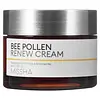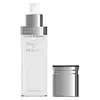What's inside
What's inside
 Key Ingredients
Key Ingredients

 Benefits
Benefits

 Concerns
Concerns

No concerns
 Ingredients Side-by-side
Ingredients Side-by-side

Pollen Extract
EmollientWater
Skin ConditioningButylene Glycol
HumectantGlycerin
HumectantSqualane
EmollientButyrospermum Parkii Butter
Skin ConditioningHydrogenated Poly(C6-14 Olefin)
EmollientAlcohol
AntimicrobialGlyceryl Stearate
EmollientCaprylic/Capric Triglyceride
MaskingCaprylic/Capric/Myristic/Stearic Triglyceride
EmollientNiacinamide
SmoothingMacadamia Integrifolia Seed Oil
Skin Conditioning1,2-Hexanediol
Skin ConditioningPEG-40 Stearate
EmulsifyingCyclopentasiloxane
EmollientCetearyl Alcohol
EmollientPentylene Glycol
Skin ConditioningPanthenol
Skin ConditioningCyclohexasiloxane
EmollientPolymethylsilsesquioxane
Sorbitol
HumectantPEG-100 Stearate
Raffinose
Skin ConditioningSynthetic Beeswax
Emulsion StabilisingPolyacrylate-13
Cetyl PEG/PPG-10/1 Dimethicone
EmulsifyingPEG-30 Dipolyhydroxystearate
EmulsifyingPalmitic Acid
EmollientPolyisobutene
Stearic Acid
CleansingCaprylyl Glycol
EmollientHydroxyacetophenone
AntioxidantTocopheryl Acetate
AntioxidantCopernicia Cerifera Wax
Ethylhexylglycerin
Skin ConditioningHydrogenated Lecithin
EmulsifyingAdenosine
Skin ConditioningPolysorbate 20
EmulsifyingSorbitan Isostearate
EmulsifyingHelianthus Annuus Seed Oil
EmollientLavandula Angustifolia Oil
MaskingDisodium EDTA
Melia Azadirachta Flower Extract
Skin ConditioningDextrin
AbsorbentMelia Azadirachta Leaf Extract
Skin ConditioningTheobroma Cacao Seed Extract
AntioxidantCurcuma Longa Root Extract
MaskingOcimum Sanctum Leaf Extract
Skin ConditioningRoyal Jelly Extract
Skin ConditioningPelargonium Graveolens Flower Oil
MaskingAnthemis Nobilis Flower Oil
MaskingLeontopodium Alpinum Callus Culture Extract
AntioxidantMyristic Acid
CleansingCananga Odorata Flower Oil
MaskingCitrus Aurantium Bergamia Fruit Oil
MaskingAspalathus Linearis Leaf Extract
Skin ConditioningArachidic Acid
CleansingPropanediol
SolventCorallina Officinalis Extract
Skin ConditioningLauric Acid
CleansingRosa Damascena Flower Oil
MaskingAnthemis Nobilis Flower Extract
MaskingOleic Acid
EmollientTocopherol
AntioxidantCholeth-24
EmulsifyingHoney Extract
HumectantChrysanthemum Boreale Flower Extract
AntioxidantPropolis Extract
Skin ConditioningSodium Hyaluronate
HumectantCeramide NP
Skin ConditioningPhenethyl Alcohol
MaskingMaltodextrin
AbsorbentHydrolyzed Royal Jelly Protein
Skin ConditioningPollen Extract, Water, Butylene Glycol, Glycerin, Squalane, Butyrospermum Parkii Butter, Hydrogenated Poly(C6-14 Olefin), Alcohol, Glyceryl Stearate, Caprylic/Capric Triglyceride, Caprylic/Capric/Myristic/Stearic Triglyceride, Niacinamide, Macadamia Integrifolia Seed Oil, 1,2-Hexanediol, PEG-40 Stearate, Cyclopentasiloxane, Cetearyl Alcohol, Pentylene Glycol, Panthenol, Cyclohexasiloxane, Polymethylsilsesquioxane, Sorbitol, PEG-100 Stearate, Raffinose, Synthetic Beeswax, Polyacrylate-13, Cetyl PEG/PPG-10/1 Dimethicone, PEG-30 Dipolyhydroxystearate, Palmitic Acid, Polyisobutene, Stearic Acid, Caprylyl Glycol, Hydroxyacetophenone, Tocopheryl Acetate, Copernicia Cerifera Wax, Ethylhexylglycerin, Hydrogenated Lecithin, Adenosine, Polysorbate 20, Sorbitan Isostearate, Helianthus Annuus Seed Oil, Lavandula Angustifolia Oil, Disodium EDTA, Melia Azadirachta Flower Extract, Dextrin, Melia Azadirachta Leaf Extract, Theobroma Cacao Seed Extract, Curcuma Longa Root Extract, Ocimum Sanctum Leaf Extract, Royal Jelly Extract, Pelargonium Graveolens Flower Oil, Anthemis Nobilis Flower Oil, Leontopodium Alpinum Callus Culture Extract, Myristic Acid, Cananga Odorata Flower Oil, Citrus Aurantium Bergamia Fruit Oil, Aspalathus Linearis Leaf Extract, Arachidic Acid, Propanediol, Corallina Officinalis Extract, Lauric Acid, Rosa Damascena Flower Oil, Anthemis Nobilis Flower Extract, Oleic Acid, Tocopherol, Choleth-24, Honey Extract, Chrysanthemum Boreale Flower Extract, Propolis Extract, Sodium Hyaluronate, Ceramide NP, Phenethyl Alcohol, Maltodextrin, Hydrolyzed Royal Jelly Protein
Galactomyces Ferment Filtrate
HumectantWater
Skin ConditioningGlycerin
HumectantNiacinamide
SmoothingPentylene Glycol
Skin ConditioningSodium Benzoate
MaskingPotassium Sorbate
Preservative1,2-Hexanediol
Skin ConditioningAcetyl Glutamine
Skin ConditioningLecithin
EmollientBacillus/Folic Acid Ferment Filtrate Extract
AntioxidantButylene Glycol
HumectantCaprylyl Glycol
EmollientSodium Hyaluronate
HumectantCaprylic/Capric Triglyceride
MaskingHydrogenated Lecithin
EmulsifyingGlucose
HumectantArginine
MaskingHydroxypropyl Methylcellulose
Emulsion StabilisingCitric Acid
BufferingCI 77220
Cosmetic ColorantAcetyl Glucosamine
Skin ConditioningAscorbic Acid
AntioxidantGlutathione
Sh-Oligopeptide-1
Skin ConditioningSh-Oligopeptide-2
Skin ConditioningSh-Polypeptide-1
Skin ConditioningSh-Polypeptide-11
Sh-Polypeptide-9
Skin ConditioningGalactomyces Ferment Filtrate, Water, Glycerin, Niacinamide, Pentylene Glycol, Sodium Benzoate, Potassium Sorbate, 1,2-Hexanediol, Acetyl Glutamine, Lecithin, Bacillus/Folic Acid Ferment Filtrate Extract, Butylene Glycol, Caprylyl Glycol, Sodium Hyaluronate, Caprylic/Capric Triglyceride, Hydrogenated Lecithin, Glucose, Arginine, Hydroxypropyl Methylcellulose, Citric Acid, CI 77220, Acetyl Glucosamine, Ascorbic Acid, Glutathione, Sh-Oligopeptide-1, Sh-Oligopeptide-2, Sh-Polypeptide-1, Sh-Polypeptide-11, Sh-Polypeptide-9
 Reviews
Reviews

Ingredients Explained
These ingredients are found in both products.
Ingredients higher up in an ingredient list are typically present in a larger amount.
1,2-Hexanediol is a synthetic liquid and another multi-functional powerhouse.
It is a:
- Humectant, drawing moisture into the skin
- Emollient, helping to soften skin
- Solvent, dispersing and stabilizing formulas
- Preservative booster, enhancing the antimicrobial activity of other preservatives
Butylene Glycol (or BG) is used within cosmetic products for a few different reasons:
Overall, Butylene Glycol is a safe and well-rounded ingredient that works well with other ingredients.
Though this ingredient works well with most skin types, some people with sensitive skin may experience a reaction such as allergic rashes, closed comedones, or itchiness.
Learn more about Butylene GlycolThis ingredient is an emollient, solvent, and texture enhancer. It is considered a skin-softener by helping the skin prevent moisture loss.
It helps thicken a product's formula and makes it easier to spread by dissolving clumping compounds.
Caprylic Triglyceride is made by combining glycerin with coconut oil, forming a clear liquid.
While there is an assumption Caprylic Triglyceride can clog pores due to it being derived from coconut oil, there is no research supporting this.
Learn more about Caprylic/Capric TriglycerideCaprylyl Glycol is a humectant and emollient, meaning it attracts and preserves moisture.
It is a common ingredient in many products, especially those designed to hydrate skin. The primary benefits are retaining moisture, skin softening, and promoting a healthy skin barrier.
Though Caprylyl Glycol is an alcohol derived from fatty acids, it is not the kind that can dry out skin.
This ingredient is also used as a preservative to extend the life of products. It has slight antimicrobial properties.
Learn more about Caprylyl GlycolGlycerin is already naturally found in your skin. It helps moisturize and protect your skin.
A study from 2016 found glycerin to be more effective as a humectant than AHAs and hyaluronic acid.
As a humectant, it helps the skin stay hydrated by pulling moisture to your skin. The low molecular weight of glycerin allows it to pull moisture into the deeper layers of your skin.
Hydrated skin improves your skin barrier; Your skin barrier helps protect against irritants and bacteria.
Glycerin has also been found to have antimicrobial and antiviral properties. Due to these properties, glycerin is often used in wound and burn treatments.
In cosmetics, glycerin is usually derived from plants such as soybean or palm. However, it can also be sourced from animals, such as tallow or animal fat.
This ingredient is organic, colorless, odorless, and non-toxic.
Glycerin is the name for this ingredient in American English. British English uses Glycerol/Glycerine.
Learn more about GlycerinHydrogenated Lecithin is created from the hydrogenation of lecithin (a group of phospholipids). Hydrogenation is a chemical reaction between hydrogen and another element.
This ingredient is an emollient and emulsifier. As an emollient, it helps soften skin by trapping moisture within. As an emulsifier, it prevents oil and water ingredients from separating.
Niacinamide is a multitasking form of vitamin B3 that strengthens the skin barrier, reduces pores and dark spots, regulates oil, and improves signs of aging.
And the best part? It's gentle and well-tolerated by most skin types, including sensitive and reactive skin.
You might have heard of "niacin flush", or the reddening of skin that causes itchiness. Niacinamide has not been found to cause this.
In very rare cases, some individuals may not be able to tolerate niacinamide at all or experience an allergic reaction to it.
If you are experiencing flaking, irritation, and dryness with this ingredient, be sure to double check all your products as this ingredient can be found in all categories of skincare.
When incorporating niacinamide into your routine, look out for concentration amounts. Typically, 5% niacinamide provides benefits such as fading dark spots. However, if you have sensitive skin, it is better to begin with a smaller concentration.
When you apply niacinamide to your skin, your body converts it into nicotinamide adenine dinucleotide (NAD). NAD is an essential coenzyme that is already found in your cells as "fuel" and powers countless biological processes.
In your skin, NAD helps repair cell damage, produce new healthy cells, support collagen production, strengthen the skin barrier, and fight environmental stressors (like UV and pollution).
Our natural NAD levels start to decline with age, leading to slower skin repair, visible aging, and a weaker skin barrier. By providing your skin niacinamide, you're recharging your skin's NAD levels. This leads to stronger, healthier, and younger looking skin.
Another name for vitamin B3 is nicotinamide. This vitamin is water-soluble and our bodies don't store it. We obtain Vitamin B3 from either food or skincare. Meat, fish, wheat, yeast, and leafy greens contain vitamin B3.
The type of niacinamide used in skincare is synthetically created.
Learn more about NiacinamidePentylene glycol is typically used within a product to thicken it. It also adds a smooth, soft, and moisturizing feel to the product. It is naturally found in plants such as sugar beets.
The hydrophilic trait of Pentylene Glycol makes it a humectant. As a humectant, Pentylene Glycol helps draw moisture from the air to your skin. This can help keep your skin hydrated.
This property also makes Pentylene Glycol a great texture enhancer. It can also help thicken or stabilize a product.
Pentylene Glycol also acts as a mild preservative and helps to keep a product microbe-free.
Some people may experience mild eye and skin irritation from Pentylene Glycol. We always recommend speaking with a professional about using this ingredient in your routine.
Pentylene Glycol has a low molecular weight and is part of the 1,2-glycol family.
Learn more about Pentylene GlycolSodium Hyaluronate is hyaluronic acid's salt form. It is commonly derived from the sodium salt of hyaluronic acid.
Like hyaluronic acid, it is great at holding water and acts as a humectant. This makes it a great skin hydrating ingredient.
Sodium Hyaluronate is naturally occurring in our bodies and is mostly found in eye fluid and joints.
These are some other common types of Hyaluronic Acid:
Learn more about Sodium HyaluronateWater. It's the most common cosmetic ingredient of all. You'll usually see it at the top of ingredient lists, meaning that it makes up the largest part of the product.
So why is it so popular? Water most often acts as a solvent - this means that it helps dissolve other ingredients into the formulation.
You'll also recognize water as that liquid we all need to stay alive. If you see this, drink a glass of water. Stay hydrated!
Learn more about Water